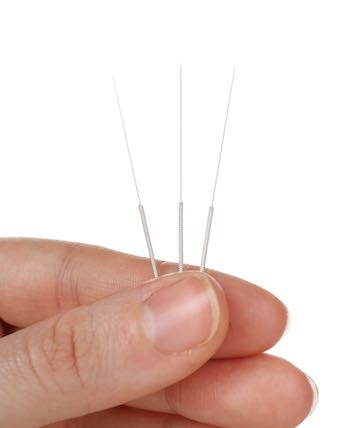Stanford University doctors conclude that acupuncture during surgery reduces pain. Research published in The Laryngoscope finds acupuncture effective for reducing pain and improving restoration of a normal diet postoperatively when acupuncture is applied during surgery.  Doctors from the Stanford University School of Medicine conclude that acupuncture is “feasible, well tolerated, and results in improved pain and earlier return of diet postoperatively.”
Doctors from the Stanford University School of Medicine conclude that acupuncture is “feasible, well tolerated, and results in improved pain and earlier return of diet postoperatively.”
The research was conducted by doctors from two Stanford University School of Medicine (Palo Alto, California) departments, the Department of Otolaryngology-Head and Neck Surgery and the Department of Anesthesia.
A randomized-controlled investigation of acupuncture’s benefits to pediatric tonsillectomy patients reveals that acupuncture patients “experienced significantly less pain at various postoperative time points as compared to the control cohort, and also that the onset of analgesia in the acupuncture cohort began by 36 hours postoperatively, whereas the control group did not reach significant analgesia until 84 hours postoperatively.”
Postoperative oral intake improved for patients receiving acupuncture during the tonsillectomy operation. The researchers note, “Oral intake was significantly more improved in the acupuncture group than the control group (P = 0.01).” They add that “the acupuncture group had significantly increased oral intake starting at 24 hours and lasting through all remaining time points examined, whereas the control group had significantly increased oral intake starting at 72 hours postoperatively.”
Measures of intraoperative acupuncture on nausea and vomiting did not produce significantly different results for the acupuncture and control groups. Out of a total of 59 patients, five acupuncture group patients experienced nausea or vomiting. Similarly, seven control group patients experienced nausea or vomiting. The researchers note that the numbers are not statistically significant (P = 0.12). Overall, the researchers note that the rates of nausea and vomiting were “very low” for both groups and that this may be attributed to “other factors in our regimen” including surgical techniques, gastric suctioning, etc… The researchers comment, “We do, however, find the differences between the treatment and control groups in postoperative pain scores to be clinically significant, particularly when treatment resulted in an earlier improvement of oral intake.” 
Researchers note that no adverse side effects from acupuncture occurred. They comment that only sterile disposable acupuncture needles were used, adding that this may have averted adverse effects. The researchers note, “Complications related to acupuncture are very rare….” In many states, including California where the investigation was conducted, only sterile disposable needles are legal for use during acupuncture. Although autoclaving sterilizes needles, reusable needles are not used in California and many other states. Single use sterile disposable needles have quickly become the national standard in the USA. The American Association of Acupuncture and Oriental Medicine (AAAOM) and the National Certification Commission for Acupuncture and Oriental Medicine (NCCAOM) “note that not a single death has been reported to result from acupuncture in the US.”
The Stanford University researchers note that the study of acupuncture during surgery is a “relatively new area of research.” They add, “One of the strengths of this study is its rigorous double-blinded randomized design with a sham acupuncture control.” Based on the positive patient outcomes for both pain reduction and oral intake restoration, the researchers suggest further studies with larger sample sizes.
Acupuncture Procedure
Electroacupuncture was applied intraoperatively at alternating frequencies between 4 and 100 Hz with a Pantheon Research stimulator. Electroacupuncture connected acupoints LI4 (Hegu) to ST36 (Zusanli) and P6 (Neiguan) to TB5 (Waiguan). Electroacupuncture was also applied to acupoint KD6 (Zhaohai). The researchers comment that alternating frequencies between 4 and 100 Hz were utilized to “optimize the release of endogenous endorphins, enkephalins, and dynorphins.” ST36 was chosen for its “analgesic properties,” LI4 and KD6 were chosen for their analgesic actions on the throat, head, and neck; and PC6 was chosen for its antiemetic properties. All needles were inserted to a depth wherein a deqi fascial grab was achieved. The needle depth ranged between approximately 0.5 - 1.0 cun.
Acupoint HT7 (Shenmen), located on the wrist, was added for its ability to reduce “postoperative agitation.” No electroacupuncture was added to HT7 or auricular acupuncture points. Seirin brand auricular acupuncture “junior tacks” were added to outer ear points shenmen, master cerebral, cingulate gyrus, and tonsil.
The double-blind, randomized, placebo-controlled study finds intraoperative acupuncture effective for reducing pain and improving postoperative oral intake. Integration of acupuncture into the operatory was also found both feasible and well tolerated. Funding sources are the Stanford University Medical Scholars Research Program, Howard Hughes Medical Institute Medical Fellow Program, and the Stanford Children’s Health Research Institute Akiko Yamazaki and Jerry Yang Faculty Scholar. Disclosures note that no conflicts of interest or other sources of funding or financial relationships exist. The research is published in The Laryngoscope, a publication of The American Laryngological, Rhinological and Otological Society.
Reference:
Tsao, Gabriel J., Anna H. Messner, Jeannie Seybold, Zahra N. Sayyid, Alan G. Cheng, and Brenda Golianu. "Intraoperative acupuncture for posttonsillectomy pain: A randomized, double‐blind, placebo‐controlled trial." The Laryngoscope (2015).


